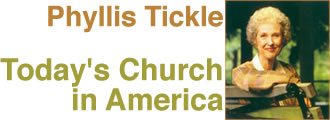
| |
|||||

|
|
||||
| |
|
|
|
||
|
||||||||||
 |
||||||||||
|
We are at a time in history of great shift or change, what Thomas Cahill calls a "hinge in history." It is comparable in every way to what happened in 70 A.D. with the destruction of the Temple and the separation of Christianity from Judaism (when Christianity became a self-conscious entity, independent of Judaism), and with what happened in the Reformation. Indeed, many of the social and cultural and political factors that made the Reformation also appertain in making the 20th century. You can draw a whole list of parallels between those two times, not the least of which, of course, is technology. As the printing press in many ways enabled and drove the Reformation, so the Internet and rapid communication of the written word has driven what it is that we have just finished. The mystics of the Middle Ages predicted, or interpreted, that the first 2,000 years of recorded history, which they dated from 2000 B.C. to the turn of the eras, was the time of God the Father; that the 2,000 years in which they were themselves living was the time of God the Son; and then [the year] 2000 (and Nostradamus sits in this window) would begin the 2,000 years of God the Spirit. They interpreted that as meaning that, progressively, God took away more and more familiar presentations or images or metaphors or representations of Himself, allowing humanity to then come in and know the next permutation and then the next one. So when we had indeed arrived at a time of understanding God the Spirit, then it would be time for consummation. Now, you may or you may not believe medieval prophets, and you may take it for what it's worth, but it certainly would seem—as many people have commented in the last ten years—that part of what they had to say was correct—that there has been an enormous shift in Christianity from God the Father and God the Son to an emphasis on God the Holy Spirit. Part of that is indeed social, but part of it is also extraneous to society. When I talk about Azusa Street and what happened—the baptism of the spirit, the coming of the charisma, and the sanctification process—I have a really hard time thinking that that was socially caused. There are many historians of American religion who will say that it did indeed have its precursors in the holiness movement. They will give you this long diatribe about how there were factors that led into it. Of course there were factors that led into it. But the truth still is that at Azusa Street something happened that dramatically changed the nature and face of American religions, and it was not humanly generated. It was not of human origin, nor for the life of me can I believe it was in any way socially caused. What happened was the baptism of the spirit and the birth of Pentecostalism. It was a whole new vision that once again we could be the church that was started on that day when the Spirit descended. That's the beginning of a spirit toward change. It's the beginning of our pulling that one of the three cables out through the sleeve and through the story, and looking at it and beginning to play with it. The next significant date I mentioned to you was 1937. Technically speaking, that year should be 1935, but nothing significant happened until 1937 and the coming of Alcoholics Anonymous and with it the whole notion of spiritual community. When people are grouped together on the basis of geography—as churches usually are—or on the basis of economics, or profession, you get associations and institutions. When people are grouped together on the basis of pain, you get a whole different thing. Whatever else you want to call it, it is, first of all, a spiritual community. It is not an association. It is a meeting of the hearts beyond the meetings of the pocketbook or inculturation of the mind. It was our first experiment with or understanding of the ability to talk about the Force without giving it a doctrinally specific name, talking about God in a spiritual way. Another significant date was 1965 because of the change in the immigration laws. For the first time in the 20th century, we were allowed to have real daily intercourse with Asian cultures and with their long tradition of spiritual conversation—their absolute total comfort in moving in the world of the spirit as easily as we move in the world of the body. So this too gave us rhetoric—it gave us social license almost to begin to talk about spiritual things. From 1965 on you can watch the whole flow of increasing comfort in talking about spirituality and spiritual work. Around 1991 and 1992 we began to say to ourselves, "What is it in all of this world of spirituality that is indigenous to Western culture? What is it that I as a Christian can have out of this world?” And suddenly we hit upon angels. Within three or four years, every self-respecting Episcopal refrigerator in the country had three or four angel magnets on it. Then we went on to saints. Remember the saints in about 1992 or 1993? Then we particularized it down to the Celtic saints. Then we got to the silly level that if it were printed in green, you could sell it regardless of what it said. Celtic spirituality came in the early 1990s. It really is an attempt to have a spiritual life as a Christian in America in the closing days of the 20th century. You can watch that progression from the “ooey gooey” God spirituality to the angels and then Celtic spirituality. It becomes a kind of wonderful thing to see. |
|||||||||
 |
 |
||||
| Copyright ©1999-2007
explorefaith.org
|
|||||